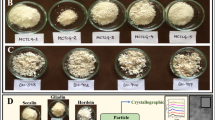Abstract
The homologus 20 kD prolamin from kodo millet and other minor millets viz. barnyard, little and foxtail millets, were purified using preparative gel electrophoresis and reversed phase high performance liquid chromatography (RP-HPLC). The amino acid composition of the purified 20 kD prolamin protein from different minor millets revealed higher content of glutamic acid, alanine, leucine and serine and lower quantity of lysine and methionine. They contain 55 to 58 percent of non-polar amino acids which make them more hydrophobic than other protein fractions. The total number of amino acid residues per polypeptide chain ranged from 152 to 155 based on theoretical calculation. Peptide mapping of the 20 kD prolamin hydrolyzed with trypsin gave fewer cleavage products than expected. The antigenic relationships among these minor millets and cereals viz. wheat, maize, rice, sorghum, finger millet and pearl millet were studied using the antibody raised against the 20 kD prolamin. Cross reactivity was seen in all the minor millets at the 20 kD region. But in barnyard and little millets lower molecular weight polypeptides also cross reacted with the antibody. Immunoblotting studies revealed that the prolamins from other cereals and millets are related to the 20 kD prolamin of kodo millet. Rice was the only common cereal that did not cross react immunologically with the antibody raised against 20 kD prolamin of kodo millet.
Similar content being viewed by others
References
Osborne TB, Mendel LB (1914). Nutritive properties of the maize kernel. J Biol Chem 18: 1–16.
Esen A, Bietz JA, Paulis JW, Wall JS (1985). Isolation and characterization of a methionine rich protein from maize endosperm. J Cereal Sci 3: 143–152.
Bietz JA (1982). Cereal prolamin evolution and homology revealed by sequence analysis. Biochem Genet 20: 1039–1053.
Taylor JRN, Schussler L, Van der Walt WH (1984). Fractionation of proteins from low tannin sorghum grain. J Agric Food Chem 32: 149–154.
Chandna M, Matta NK (1990). Characterization of pearl millet protein fractions. Phytochemistry 29: 3395–3399.
Ottoboni LMM, Leite A, Targon MLN, Crozler A, Arruda P (1990). Characterization of the storage protein in seeds ofCoix lacryma — Jobi var. Adlay. J Agric Food Chem 38: 631–635.
Monterio PV, Virupaksha TK, Rao DR (1982). Proteins of Italian millet: Amino acid composition, solubility fractionation and electrophoresis of protein fractions. J Sci Food Agric 33: 1072–1079.
Monterio PV, Sudharshana L, Ramachandra G (1988). Japanese Barnyard millet (Echinochloa frumentacea) protein content, quality and SDS-PAGE of protein fractions. J Sci Food Agric 43: 17–25.
Parvathy K, Thayumanavan B (1995). Homologies between prolamins of different minor millets. Plant Foods Hum Nutr 48: 119–126.
Landry J, Moureaux T (1970). Hetero genetic des glutelins du grain de mais, extraction elective et composition an acids amines des trois fractions. Isolees Bull Soc Chem Biol 52: 1021–1037.
Esen A (1988). Immunological cross reactivity among alpha-zein of maize (zea mays L.) J Cereal Sci 8: 93–109.
Shull JM, Watterson JJ, Kirlies AW (1991). Proposed nomenclature for the alcoholsoluble proteins (kafirins) ofSorghum bicolor (L.) Moench based on molecular weight, solubility and structure. J Agric Food Chem 39: 83–87.
Dierks-Ventling C, Cozens K (1982). Immunochemical cross reactivity between zein, hordein and gliadin. FEBS Lett 142: 147–150.
Naren AP, Virupaksha TK (1990). Effect of sulfur deficiency on synthesis of alphasetarin, a methionine-rich protein of Italian millet. Cereal Chem 67: 136–138.
Harlow ED, Lane D (1988). Antibodies: A laboratory manual. New York: Cold Spring Harbor Laboratory Publications, 670 pp.
Wilkinson JM, (1986). Fragmentation of polypeptides by enzymic methods. In: Darbre A (ed), Practical Protein Chemistry: A hand book. London: John Wiley and Sons, pp 122–146.
Titus DE (1991). Promega protocols and application guide, 2nd edn. 422 pp.
Laemmli UK (1970). Cleavage of structural proteins during the assembly of bacteriophage T4. Nature 227: 680–685.
Towbin H, Stalhelin T, Gorden J (1979). Electrophoretic transfer of protein from polyacrylamide gel to nitrocellulose sheets. Procedure and some applications. Proc Natl Acad Sci 76: 4350–4354.
Paulis JW, Bietz JA (1986). Separation of alcohol soluble maize proteins by reversed phase high performance liquid chromatography. J Cereal Sci 4: 205–216.
Horikoshi M, Kobayashi H, Yamazoe Y, Mikami B, Morita Y (1991). Purification and complete amino acid sequence of major prolamin of rice endosperm. J Cereal Sci 14: 1–14.
Bietz JA, Huebner FR, Rothfus JA (1970). Chromatographic comparisons of peptic digests of individual gliadin proteins. Cereal Chem 47: 393–404.
Krishnan HB, Franceschi VR, Okita TW (1986). Immunochemical studies on the role of the golgi complex in protein body formation in rice seeds. Planta 169: 471–480.
Wen TN, Luthe DS (1985). Biochemical characterization of rice glutelins. Plant Physiol 78: 172–177.
Skerritt JH, Lew PY (1990). Homologies between grain storage proteins of different cereal species I. Monoclonal antibody reaction with total protein extracts. J Cereal Sci 11: 103–121.
Skerritt JH, Smith AR, Wringley CW, Underwood PA (1984). Monoclonal antibodies to gliadin proteins used to examine cereal grain protein homologies. J Cereal Sci 2: 215–224.
Festenstein GN, Hay FC, Shewry PR (1987). Immunochemical relationships of the prolamin storage proteins of barley, wheat, rye and oats. Biochem Biophys Acta 912: 371–383.
Mazhar H, Chandrasekar A, Shetty HS (1993). Isolation and immunochemical characterization of the alcohol extractable proteins (Kafirins) of sorghum. J Cereal Sci 17: 83–93.
Author information
Authors and Affiliations
Rights and permissions
About this article
Cite this article
Parameswaran, K.P., Thayumanavan, B. Isolation and characterization of a 20 kD prolamin from kodo millet (Paspalum scrobiculatum) (L.): Homology with other millets and cereals. Plant Food Hum Nutr 50, 359–373 (1997). https://doi.org/10.1007/BF02436082
Received:
Accepted:
Issue Date:
DOI: https://doi.org/10.1007/BF02436082




